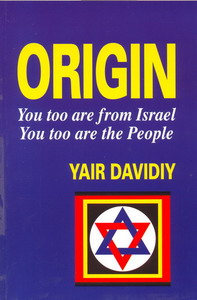Brit-Am Ephraimite Forum no. 68
Brit-Am Ephraimite Discussion. News and Issues concerning the Lost Ten Tribes and Judah in the World Today.
For Previous issues see:
Ephraimite Forum Archives
Ephraimite
Forum
no.68

The Brit-Am Rose
Official Symbol of Brit-Am
Ephraimite Forum-68
Date: 7/July/08 4th Tammuz 5768
Contents:
1. Holocaust:
Involvement of Wehrmacht
and German Civilians in "Final Solution"
2. Dennis Tate:
To Combat Global Warming: Need More Trees and Desalinated water in Dead Sea
Region!
3. Archaeology: Brit-Am Version of Explorator 11.11
1. Holocaust:
Involvement of Wehrmacht
and German Civilians in "Final Solution"
Extracts from:
H-NET BOOK REVIEW
Published by H-German@h-net.msu.edu (June 2008)
Christine Glauning.
_Entgrenzung und KZ System: Das Unternehmen "W ?ste"
und das Konzentrationslager in Bisinger 1944/1945_. Reihe "Geschichte
der Konzentrationslager 1933-1945". Berlin: Metropol Verlag, 2008. 410
pp. Charts, bibliography, appendix, index of persons, index of places.
EUR 24.00 (cloth), ISBN 978-3-938690-30-7.
Reviewed for H-German by Leonid Rein, International Institute for
Holocaust Research Yad Vashem
Armament and Terror in the Third Reich
Relevant Extracts:
In 1944, a few years
after the Nazis had proclaimed the Reich "free of Jews," Jewish forced
laborers from occupied countries were brought into Germany to work at
various armament projects.
Glauning shows that the entire camp system underwent an ever-increasing
decentralization process, whereby external camps became camps in their
own rights. In the case of Natzweiler, the external camps continued to
exist long after the main camp was evacuated in the summer 1944; members
of the commandant's office staff were distributed between various
external camps and thus these camps became autonomous bodies.
Glauning also considers the question of the Wehrmacht's involvement in
the concentration camp system. In the last stages of war, the rising
number of both concentration camps and the number of inmates to be
guarded had led leaders to supplement camp personnel with Wehrmacht
soldiers. In Bisingen, the majority of camp personnel were former
Luftwaffe members and Wehrmacht reservists. Glauning thus shows that
Wehrmacht soldiers and officers did not serve only in subordinate
capacities as camp guards. In Bisingen itself, many central positions
within the camp administration were held by Wehrmacht members, rather
than the SS ?"bloc leaders, labor unit leaders, camp physicians, and even
the camp commander were Wehrmacht members. Glauning also shows that the
presence of more Wehrmacht members did not result in better conditions
in the camps. Often (as was the case with Bisingen's camp commander,
Johannes Pauli) Wehrmacht members not only achieved levels of brutality
instituted by the SS, they surpassed them. Glauning's analysis also
incorporates research about the perpetrators, considering their motives
and larger behavioral patterns. She focuses on two different people:
Pauli, and his immediate superior, Franz-Johann Hoffmann. Although the
men came from different backgrounds (Hoffmann was a member of the lower
middle-class and SS veteran; Pauli came from a more bourgeois
background), Glauning shows that both men underwent a "school" of
violence at various stages of their lives and acquired similarly radical
fixed images of their supposed enemies.
Changes in camp leadership led to changes in inmate hierarchies. Whereas
German criminals were originally appointed to "Kapo" positions, in this
later phase, East Europeans and even Jews could be appointed as
_Funktionsh ftlinge_ (inmate-functionaries). This fact did not mean that
the Nazis had entirely abandoned racial ideology, and Jewish inmates
still were subjected to brutal maltreatment. Neither did the increased
need for inmate labor result in better treatment. Leaders' desires to
get the most out of prisoners led to drastic increases in mortality
rates in Bisingen and in other labor camps. In Bisingen, around 1,200
inmates died between October 1944 and mid-April 1945 as a result of
appalling living and working conditions and brutal maltreatment on the
part of both camp personnel and factory officials.
Glauning shows that not only SS guards, but representatives of the
Organization Todt and private firms as well treated prisoners as slaves,
driving them to work using physical and verbal violence; they, too, were
responsible for the deaths of thousands of prisoners. At the same time,
Glauning shows the inability of SS apparatus to bridge the gap between
ideology and pragmatic requirements. Notwithstanding the fact that in
the course of his inspection of Bisingen, Oswald Pohl himself harshly
criticized the inhuman conditions in the camp, this did not led to any
noticeable improvement in either living or work conditions. After Pohl's
inspection, Bisingen's mortality rates increased dramatically. Between
December 1944 and mid-April 1945, 967 prisoners died in Bisingen. Thus
contrary to the current trend in German research, which ascribes more
importance to economic considerations than to pure ideology in National
Socialist policy in various spheres,[3] Glauning maintains that to the
very end ideological motives were of great importance.
Glauning sees in the development of the oil shale project an interplay
between rationality and irrationality, between pragmatism and
ideological dogmatism. Even if the whole project was launched for
reasons that had little to do with rationality and pragmatism, people
engaged in various stages of the project's development acted out of
rational motives, be it the implementation of their research skills or
efforts to secure workers or facilities. Glauning destroys the image of
concentration camps at the end period of the Third Reich as bodies
centrally administered, ruled by SS, and cordoned off from their
surroundings. In fact she applies the term "Entgrenzung" (dissolution of
boundaries), especially in terms of the relations between the camps and
their surroundings. In Bisingen, villagers came into everyday contact
with the camp, whether via the sight of inmates passing through the
streets on their way to work, the accommodation of camp personnel, or
collaboration in the apprehension of escapees. Glauning also destroys or
at least corrects the so-called "Bisingen myth," which portrayed the
population of Bisingen as protesting against the inhuman treatment of
camp's inmates or even assisting prisoners in various ways.
Glauning's study is well written and easy to read. It provides an
interesting, important contribution to both the history of the Nazi
armament program and the history of concentration camps in the later
stages of the Third Reich.
2. Dennis Tate:
To Combat Global Warming: Need More Trees and Desalinated water in Dead Sea
Region!
From: Dennis Tate <tate4pictoucentre@yahoo.ca>
I suspect Israel's Dead Sea is a key to combatting global warming!
Extracts:
"It is my firm belief that the number one technological device to reduce
atmospheric greenhouse gases has already been invented. It is the tree.
"What is desperately needed at this time is not necessarily a new mechanical
device but instead a paradigm shift in economic theory regarding monetary
policy. We require a readily understandable explanation on how leaders in
business and government can direct not only millions, but actually trillions of
dollars of investment into combating global warming.
"One of the most effective practical methods that could be put into place in the
least amount of time would be dozens of the largest possible desalinization
plants all along the Mediterranean and Red Seas. Huge quantities of fresh water
could be dripped onto the Sinai and Sahara deserts and voila, well chosen
species of newly planted fast growing trees could soon change the color of these
relatively desolate areas, significantly reduce atmospheric CO2, positively
affect local weather patterns and at the same time significantly counterbalance
the increases in worldwide ocean levels as the polar ice caps melt. This will
buy us some extra time and thus expand the "very brief window of opportunity to
deal with climate change."
"So who is going to finance the construction of all these massive installations
not to mention the planting of all those seedling trees?"...(Denns Tate, 2007)
My second submission emphasizes the writings of New Mexico biologist Carl
Cantrell:
http://hauns.com/~DCQu4E5g/globwarm.html
Global Warming II by Carl Cantrell
"So how is our problem of continental drying causing global warming? It all has
to do with vegetation and sunlight. When sun light hits a plant, it causes a
process which we call photosynthesis where the energy from the sun light creates
oxygen for us to breath, water for us to drink, and is stored as sugar for
plants and animals to use. When the same sun light hits the soil, all of its
energy turns into heat and is radiated back into the atmosphere, carried away by
running surface water such as rain fall, is carried away to other areas by our
winds, and diffuses down into the soil towards the earth's crust. All of this
warms our planet increasing its average temperature."
"Therefore, the less vegetation you have on the planet, the more sunlight is
being turned into heat and the warmer the planet becomes. This is very critical
because warmer and dryer winds dry out other land areas faster decreasing the
vegetation on those land areas. Less humidity in the air also reflects less sun
light back out into space so that more sun light strikes the earth and more heat
is generated?."
"The truth is that you can do more to decrease global warming by just reducing
the average temperature for the Sahara Desert by one or two degrees than if we
humans completely quit using fossil fuels and returned to the cave".
"So, how would you start working to resolve this problem? Easy, cool the deserts
and get some vegetation growing on them as soon as possible. But the method is
much more complex than that. You have to use the prevailing trade winds in
relation to the deserts to get the best results as quickly as possible and it
will be extremely expensive".
"Then we build desalination plants along the coast near these water sheds and
pipe water to the tops or ridges of the water sheds".
"This will do a number of things. First, it will increase the moisture in the
desert soil so that it will develop water tables and water will begin to run in
the streams. This water will increase the amount of vegetation in the area and
decrease the amount of heat being generated by sun light cooling the watered
area and all areas down wind of the watered area. As more available water
evaporates, it will cool the air and reflect more sun light back out into space
cooling the area even more. Cooler and more humid air will have less of a
heating effect on areas down wind and will reflect more sun light back into
space in those areas cooling areas we won't be watering yet. Cooler and more
humid air will also have less of a warming effect on our seas and oceans."
"Rain water running off of cooler soil will decrease the heating effect on our
oceans and our planet crusts which will decrease catastrophic storm activities
for other areas and seismic activity for the entire planet. Also, returning more
ocean water to the surface and aquifers of our continents will lower the sea
levels providing more usable land for us to farm and build on."
"With cooler desert areas and increasing vegetation, less water will evaporate
from our deserts increasing the amount of surface water even more and increasing
the amount of vegetation and animal life by huge amounts because deserts
currently take up more than 20% of our land surface. Populations will be able to
spread out and there will be less competition for existing land areas."
What we need is to develop a process where ocean water is desalinated on a
massive scale thus drastically reducing the cost.
Can anybody here guess why I believe your Dead Sea could be the key to combating
global warming?
(This discussion has been originally put forward on this facebook discussion
group):
http://ucsc.facebook.com/topic.php?topic=5497&post=21705&uid=5086517439#post21705
3. Archaeology: Brit-Am Version of
Explorator
11.11
From: david meadows <rogueclassicist@gmail.com>
===================================================
explorator 11.11 July 6, 2008
===================================================
=================================================
ANCIENT NEAR EAST AND EGYPT
=================================================
A (bizarre) sacrifice-'burial' of an acrobat and horses from
Syria:
http://www.newkerala.com/one.php?action=fullnews&id=80453
An ancient 'royal structure' from Northern Iran:
http://www.newkerala.com/one.php?action=fullnews&id=78709
Plans are afoot to excavate the Chehrabad salt mine:
http://www.mehrnews.ir/en/NewsDetail.aspx?NewsID=708534
http://www.tehrantimes.com/index_View.asp?code=172160
Some 'new' fragments of Leviticus from the Judean desert:
http://www.nzherald.co.nz/section/2/story.cfm?c_id=2&objectid=10520219
Very interesting ink-on-stone 'Messiah' tablet (I suspect this will
be getting a ton of press attention):
http://www.nytimes.com/2008/07/06/
world/middleeast/06stone.html
http://www.heraldtribune.com/article/
20080705/NEWS/807050615&tc=yahoo
http://www.thestate.com/local/story/453291.html
http://seattletimes.nwsource.com/text/
2008035408_biblical06.html
They're going to fix up Tell Napoleon:
http://www.globes.co.il/serveen/globes/
docView.asp?did=1000356221&fid=1124
Review of Jonathan Wilson, *Ancestral Journeys*:
http://www.nytimes.com/2008/07/06/
books/review/Wilson-t.html
===============================================
ANCIENT GREECE AND ROME (AND CLASSICS)
====================================================
Digging the 'Ephesus of the Black Sea':
http://www.turkishdailynews.com.tr/article.php?enewsid=108524
Comparing Virgil translations:
http://www.telegraph.co.uk/opinion/main.
jhtml?xml=/opinion/2008/07/05/do0508.xml
Looking for Roman remains at Birnie:
http://news.bbc.co.uk/2/hi/uk_news/scotland
/highlands_and_islands/7487985.stm
Studying ancient attire:
http://tinyurl.com/55zagc
(Western)
==================================================
EUROPE AND THE UK (+ Ireland)
===================================================
They've been brewing beer in Ireland for quite a while, apparently:
http://www.andhranews.net/Technology/2008/
June/29-Brewing-tradition-existed-51763.asp
The public can voice their opinion about Stonehenge:
http://news.bbc.co.uk/1/hi/england/somerset/7482995.stm
More coverage of Vikings and cod:
http://tinyurl.com/5b77v5
(NS)
More coverage of that Viking burial going on display in Sweden
(with a focus on some amber gaming piece found therein):
http://www.dailyindia.com/show/254653.php/
Vikings-believed-that-their-dead-played-board
-games-on-their-way-to-the-afterlife
http://tinyurl.com/4btvhw
==============================================
NORTH AMERICA
===================================================
Dating Yankee Doodle:
http://news.yahoo.com/s/ap/20080704/
ap_on_re_us/yankee_doodle250th
http://ap.google.com/article/
ALeqM5j1AgNDunHNM9leVm-rceR57bgK6gD91MT9Q84
Looking at some early drafts of the Declaration of Independence:
http://www.nytimes.com/2008/07/05/nyregion/05declaration.html
cf:
http://www.nytimes.com/2008/07/04/opinion/04widmer.html
Sad stories from Gettysburg:
http://www.npr.org/templates/story/
story.php?storyId=92126534
Quebec City is celebrating its 400th anniversary:
http://www.france24.com/en/20080702-culture
-quebec-canada-anniversary-400-years-champlain-enigma-french
http://www.nytimes.com/2008/07/03/opinion/03fischer.html
Review of Daniel Mark Epstein, *The Lincolns: Portrait of a Marriage*:
http://www.nytimes.com/2008/07/03/books/03maslin.html
=================================================
OTHER ITEMS OF INTEREST
======================================================
On Frederick II and the rebirth of Roman culture:
http://www.iht.com/articles/2008/07/05/arts/conway.php
Interesting item on Keats:
http://www.newyorker.com/arts/critics/
books/2008/07/07/080707crbo_books_kirsch
On the origins of football (maybe) (European):
http://news.bbc.co.uk/1/hi/wales/mid/7486118.stm
Lyme disease originated in Europe:
http://www.sciencedaily.com/releases/
2008/06/080629142805.htm
I guess Occam's Razor doesn't apply to the who-wrote-Shakespeare's-plays
set:
http://www.npr.org/templates/story/
story.php?storyId=92236768
http://www.npr.org/templates/story/story.php?storyId=92142217
What makes a Stradivarius so good:
http://www.nytimes.com/2008/07/05/arts
/music/05arts-ITSALLINTHEW_BRF.html
http://www.independent.co.uk/news/science/solved-the-
mystery-of-why-stradivarius-violins-are-best-858329.html
Can't remember if we had this King-Arthur-was-French story:
http://tinyurl.com/6yg6s3
(Telegraph)
===============================================
TOURISTY THINGS
=================================================
Rhodes:
http://www.easier.com/view/Travel/
Travel_Guides/article-188292.html
Turkey:
http://www.washingtonpost.com/wp-dyn/
content/story/2008/07/03/ST2008070303497.html
Zadar:
http://travel.nytimes.com/2008/07/06/
travel/06next.html?ref=travel
Lampedusa:
http://travel.nytimes.com/2008/07/06/travel/06leopard.html
The smallest U.S. National Park:
http://www.npr.org/templates/story/story.php?storyId=92035186
====================================br>
DIG DIARIES/BLOGS
==========================================
Tel Kadesh:
http://sitemaker.umich.edu/kelseymuseum.digdiary/read_our_blog
Tel Dan:
http://teldan.wordpress.com/
============================================
EXHIBITIONS, AUCTIONS, AND MUSEUM-RELATED
================================================
Caesar:
http://www.ansa.it/site/notizie/awnplus/
english/news/2008-07-04_104232631.html
http://www.upi.com/Entertainment_News/2008/07/04/
Museum_planning_Caesar_exhibition/UPI-18451215202099/
Hadrian:
http://www.telegraph.co.uk/arts/main.jhtml
?xml=/arts/2008/07/05/bahadrian105.xml
Turner:
http://www.nytimes.com/2008/07/04/arts/design/04turn.html
Goya:
http://www.nytimes.com/2008/07/02/arts/design/02abroad.html
Nordic Heritage Museum:
http://www.nytimes.com/2008/06/30/arts/design/30conn.html

|
Origin.
You too are from Israel
You too are the People
Lost Tribes of Israel in the West.
Main Biblical and Historical Points Summarized
A fast-flowing, easy-to-read, well-presented overall view of the Scriptural and Historical evidence concerning the whereabouts of the Ten Lost Tribes of Israel
in the world today.
More Details
|
To Make an Offering to Brit-Am
Send a check to
Brit-Am
POB 595
Jerusalem 91004
Israel
or deposit a donation in our
PayPal Account
http://britam.org/books.html#donate
Contribute to Brit-Am
Correspond with us
Send Comments or Criticisms
You may not always receive an immediate answer but anything you say will be considered and appreciated
Send us an
e-mail
Books and Offering Opportunities
Main Page






